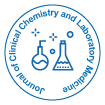
Journal of Clinical Chemistry and Laboratory Medicine
Open Access
ISSN: 2736-6588

ISSN: 2736-6588
Commentary - (2022)Volume 5, Issue 3
Despite advances in laboratory diagnostics, the clinical microbiology laboratories continues to rely significantly on traditional methods to detect microorganisms present in clinical samples, such as culture, phenotypic, and biochemical testing. Clinical microbiology, possibly more than any other branch of laboratory medicine, is advancing at a faster rate. Traditional procedures such as culture, phenotypic, and biochemical testing were employed in clinical microbiology laboratories before the invention of technology improvements to recognize the presence of microorganisms in clinical specimens. Identification techniques such as Nucleic Acid Amplification Tests (NAATs) and Analyte-Specific Reagents (ASRs) are more complicated and require highly trained personnel. New techniques such as Next- Generation Sequencing (NGS) and digital PCR were developed to tackle these issues. Along with these approaches, Matrix assisted laser desorption ionization time of Mass Spectroscopy (MALDI of MS) was developed, which is useful for identifying these cultivated microorganisms quickly and accurately. It is due in part to the clinical laboratory's processing of complicated and variable specimens. Higher levels of automation in preanalytic and postanalytic methods may result in a loss of familiarity with basic skills and concepts, such as qualitative and quantitative streaking of culture media or appropriate work procedures to minimize the exposure when working with molecular assays, reducing technologist skill sets in those areas. The problem in technologists' education is to master new abilities while preserving proficiency in traditional procedures. The welldocumented example of accepting new technologies is the shift from viral culture to primarily molecular approaches. In the clinical laboratory, molecular technologies such as PCR, microarray, and nucleic acid sequencing have featured prominently. These approaches use amplification and detection of specific nucleic acid targets to deliver sensitive and specific identification of microbes or genetic variations. The limitation of a posterior target selection inherent in traditional PCR/ probe-based assays has been overcome by recent improvements in high-density or massively parallel sequencing technology, which has increased the diagnostic possibilities of these tests. Molecular diagnostics, regardless of methodology, have the ability to shorten time to results and deliver more accurate diagnosis. Molecular diagnostic approaches, while their obvious benefits are not without flaws. Copan (WASP Lab) and BD Kiestra seem to be the only two commercially available Total Laboratory Automation (TLA) lines for clinical microbiology. Through conveyer tracks that transport plates to and from the incubators, these TLA systems connect O2, CO2, and anaerobic incubators to a central processor or task stations. The multipurpose, standalone WASP (walk-away specimen processing) unit lies at the center of WASP Lab. The WASP's various functions are performed by two independently operating robots that "receive" specimen containers, select appropriate (user-defined) plating media for each specimen type, vortex, decap, and plate the specimen, recap the specimen, and move both the samples and inoculated medium to a "completed" queue. An optional Gram slide preparation module and a "warehouse carousel" that may handle broth culture tubes to be inoculated or four Kirby-Bauer disc dispensers for automated agar-based susceptibility testing are also included in the WASP. The core module of the WASP has several advantages, including a compact footprint, adaptability, and a large number of functionalities. The BD Kiestra TLA is the second commercially available TLA line for microbiology. Unlike the WASP Lab, which relies on a multifunctional core unit connected to imaging systems and incubators, the BD Kiestra TLA is made up of a number of task-specific modules that may be designed to meet the demands of distinct laboratories. The clinical microbiology laboratory has traditionally been seen as a "low-tech" environment, lacking the automation that is increasingly prevalent in chemistry and haematology laboratories. The design and high reliability of the BD Kiestra TLA is a significant benefit. This enables laboratories to customize the system to their individual workloads and workflows while also allowing them to extend or modify the system as their needs evolve. BioMérieux is now working on a third system, the Full Microbiology Lab Automation (FMLA). MALDI-TOF MS is a fast, accurate, and low-cost identification technology that has mostly been applied for bacterial identification till now. There are other numerous different technologies in development or with minimal objective good support that will certainly play a role in clinical microbiology in the future. It will be essential for keeping clinical microbiologists'traditional expertise in these areas until new technologies are more widely available and well tested.
Citation: Buchan A (2022) Overview on Developing Techniques for the Clinical Microbiology Laboratory. J Clin Chem Lab Med. 5:213.
Received: 07-Mar-2022, Manuscript No. JCCLM-22-16731; Editor assigned: 10-Mar-2022, Pre QC No. JCCLM-22-16731 (PQ); Reviewed: 24-Mar-2022, QC No. JCCLM-22-16731; Revised: 31-Mar-2022, Manuscript No. JCCLM-22-16731 (R); Published: 07-Apr-2022 , DOI: 10.35248/JCCLM.22.05.213
Copyright: © 2022 Buchan A. This is an open-access article distributed under the terms of the Creative Commons Attribution License, which permits unrestricted use, distribution, and reproduction in any medium, provided the original author and source are credited.